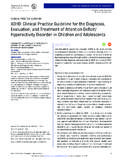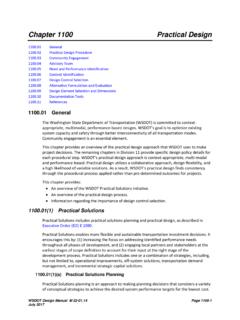Transcription of Intravenous Lidocaine for Perioperative Pain Ed, …
1 Intravenous Lidocaine for Perioperative pain 3rd Ed, 12/10 Postoperative pain is best managed with a combination of methods including regional anesthetic and analgesic techniques ( nerve blocks, local wound infiltrations, epidural catheters) along with systemically administered analgesics such as acetaminophen, non steroidal anti inflammatory drugs (NSAIDs), opioids and other adjuncts. A Perioperative multi modal approach often provides more effective pain relief than opioid treatment alone with a more favorable side effect profile. However, this approach can be cumbersome and expensive or contraindicated in some patients. Studies suggest Intravenous (IV) Lidocaine may have benefit in Perioperative pain . IV Lidocaine may be indicated as an adjunct to systemic opioids for surgical pain when other multimodal approaches such as regional analgesia are not possible. Systemic administration of Lidocaine has been shown to have analgesic actions in patients with chronic neuropathic pain .
2 Lidocaine decreases pain by inhibiting nerves through the blockade of sodium channels. Systemic Lidocaine is thought to inhibit spontaneous impulse generation arising from injured nerve fibers and the dorsal root ganglion, and by suppressing primary afferent reflexes in the spinal cord. Intravenous Lidocaine is effective for treating visceral pain and may also improve postoperative bowel function. How IV Lidocaine is administered for Perioperative pain management Contraindications: First and second degree heart conduction blocks could be aggravated and progress into a higher degree of heart block with Lidocaine administration. Cardiovascular instability and concomitant use of alpha agonists ( , clonidine) or beta blockers ( , metoprolol, labetolol) are relative contraindications. Allergies to other amide local anesthetics (bupivacaine). Allergy to Novacaine (procaine) is not a contraindication as Novacaine is an ester local anesthetic.
3 (Safety Warning: bupivacaine and ropivacaine are never given intravenously). The Anesthesiologist will bolus the patient with a higher amount at the start of an infusion; typically IV Lidocaine followed by a continuous infusion in the operating room of 2mg/kg/hour. In the recovery room and postoperatively the patient will receive a continuous infusion at a rate of approximately The exact dosing in mg/hour will be specified in the physician order. IV Lidocaine should be delivered on an Alaris pump using the Guardrails safety system. A 4mg/mL ( solution) of preservative free Lidocaine prepared as 2000 mgs in 500mL sodium chloride will be supplied by pharmacy. The infusion should be administered at the prescribed dosage until the bag runs dry. Nursing Responsibilities Assess pain and Lidocaine side effects along with routine postoperative vital signs. Telemetry is NOT necessary.
4 If the Lidocaine infusion is stopped prior to the planned end time, document primary reason for stopping, associated signs and symptoms, BP, pain level, and obtain a blood sample for serum Lidocaine level. Page the covering physician. 1 pain Fast Fact: Intravenous Lidocaine for Postoperative pain continued Permission granted to modify or adapt provided written credit is given to the University of Wisconsin Hospital & Clinics, Madison, WI Internet: Visit Intranet: More Fast Facts in UConnect under Clinical Guidelines/ pain Management Resources 2o Mild side effects always occur first as an early warning of Lidocaine toxicity. If left unchecked side effects can progress to seizures, cardiovascular collapse and death (see below). o To collect blood for serum Lidocaine level use Royal blue top or Red top tube, preferred volume 6mL. Turnaround time for test results is 3 hours if ordered stat, 24 hours for routine.
5 O Half life of Lidocaine is 1 to hours, which means the side effects typically dissipate within this time frame after stopping an infusion. The analgesic effect of Lidocaine may last longer than the pharmacologic half life. What are the potential side effects of systemic Lidocaine ? The side effects of Lidocaine are directly related to the serum Lidocaine level. There is no specific target range for pain relief as each individual s response and requirements are different, however, side effects are rare at serum levels within the 2 6 mcg/mL range. Side effects are more pronounced in patients with liver dysfunction, pulmonary diseases where the predominant problem is carbon dioxide retention, and congestive heart failure. Mild (at serum levels 3 8 mcg/mL) numbness and tingling in the fingers and toes, numbness and unusual sensations around the mouth, a metallic taste in the mouth, ringing in the ears, or lightheadedness and dizziness Moderate side effects (at serum levels 8 12 mcg/mL) includes mild side effects with the addition of nausea and vomiting, severe dizziness, decreased hearing, tremors, changes in blood pressure and pulse.
6 Nausea and vomiting without other Lidocaine side effects in the postoperative setting is unlikely to be related to the Lidocaine . Severe side effects (at serum levels greater than 12 mcg/mL) drowsiness confusion, muscle twitching, convulsions, loss of consciousness, cardiac arrhythmias, cardiac arrest. References: Groudine, , Fisher, , Kaufman, , Patel, , Wilkins, , Mehta, , Lumb, (1998). Intravenous Lidocaine speeds the return of bowel function, decreases postoperative pain , and shortens hospital stay in patients undergoing radical retropubic prostatectomy. Anesthesia and Analgesia; 86:235 239. Herroeder, S., Pecher, S., Schonherr, , Kaulitz, G., Hanenkamp, K., Friess, H., Bottiger, , Bauer, H., Dijkgraaf, , Durieux, , Hollman, (2007). Systemic Lidocaine shortens length of hospital stay after colorectal surgery. Annals of Surgery, 246(2), 192 200. Kaba, A.
7 , Laurent, , Detroz, , Sessler, , Durieux, , Lamy, , Joris, (2007). Intravenous Lidocaine infusion facilitates acute rehabilitation after laparoscopic colectomy. Anesthesiology, 106:11 18. Koppert, W., Weigand, M., Neumann, F., Sittl, R., Schuettler, J., Schmelz, M., Hering. (2008). Perioperative Intravenous Lidocaine had preventive effects on postoperative pain and morphine consumption after major abdominal surgery. Anesthesia and Analgesia, 98:1050 1055. Martin, F., Cherif, K., Gentilli, , Enel, D., Abe, E., Alvarez, , Mazoit, , Chuvin, M., Bouhassira, D., Fletcher, D. (2008). Lack of impact of Intravenous Lidocaine on analgesia, functional recovery, and nociceptive pain threshold after total hip arthroplasty. Anesthesiology, 109:118 123. Yardeni IX, Beilin B, Mayburd E, Levinson Y, Bessler H. the effect of Perioperative Intravenous Lidocaine on postoperative pain and immune function.
8 Anesthesia &Analgesia 2009;109(5):1464 1469.











